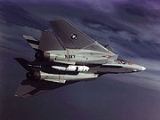
Tactical Airborne Reconnaissance Pod System
Encyclopedia
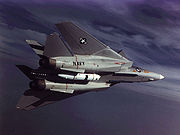
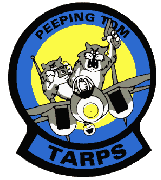
The Tactical Airborne Reconnaissance Pod System (TARPS) is a large and sophisticated camera
Camera
A camera is a device that records and stores images. These images may be still photographs or moving images such as videos or movies. The term camera comes from the camera obscura , an early mechanism for projecting images...
pod carried by the F-14 Tomcat
F-14 Tomcat
The Grumman F-14 Tomcat is a supersonic, twin-engine, two-seat, variable-sweep wing fighter aircraft. The Tomcat was developed for the United States Navy's Naval Fighter Experimental program following the collapse of the F-111B project...
. It contains three camera bays with different type camera
Camera
A camera is a device that records and stores images. These images may be still photographs or moving images such as videos or movies. The term camera comes from the camera obscura , an early mechanism for projecting images...
s which are pointed down at passing terrain. It was originally designed to provide an interim reconnaissance capability until a dedicated F/A-18 Reconnaissance version could be fielded. However, it was pressed into service upon arrival in the fleet and was still in use up to the end of Tomcat service in 2006.
TARPS pod and Tomcat interoperability
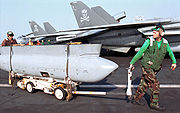
Airwing
Airwing AS is a Norwegian air taxi and charter flight operator based at Oslo Airport, Gardermoen. The company was founded in 2004, aiming to provide flights for specialised missions. Airwing administers a fleet of four Beechcraft King Air....
). All F-14Ds were modified to be TARPS capable, which allowed greater flexibility in scheduling aircraft and conducting maintenance. A control panel is fitted to the rear cockpit and the RIO has total control over pod operation except for a pilot controlled button that can activate cameras as selected by the RIO (but seldom used).
Camera bays

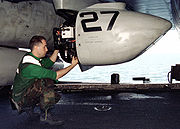
Focal length
The focal length of an optical system is a measure of how strongly the system converges or diverges light. For an optical system in air, it is the distance over which initially collimated rays are brought to a focus...
KA-99 panoramic camera which rotated from horizon to horizon and could be used for side oblique photography. Each image in the wide field of view position produced a 36" negative. The KA-99 could carry up to 2000 feet (609.6 m) of film that could be exhausted if not managed carefully by the RIO. The third camera bay held an infrared line scanner camera used for night missions or daylight mission traces. All TARPS cameras were monitored by a device call a CIPDU in the tail cone section of the pod that provided camera status to maintenance personnel and during flight provided aircraft position data onto the camera imagery for intel analysis. An electrical umbilical cord connected the pod to the control panel that was positioned on the left side of the rear cockpit. A hose from the ECS from the F-14 cooled/heated the internals of the pod in flight and kept the appropriate humidity levels constant. In 1987 VF-111 was the first squadron to deploy with a KS-153 camera system in bay two. The KS-153 used a 24" lens and was used for stand-off photography in the Persian Gulf. During Operation Desert Shield the KS-153 was used to monitor the no fly zones in Iraq.

Light table
A light table is a viewing device that is used to review photographic film or artwork placed on top of it. It provides even illumination of the subject from below through a translucent cover and fluorescent lights that emit little heat. They can also be found mounted on the walls of hospitals and...
for analyzing the hundreds of feet of film and exploiting the data.
TARPS missions
The TARPS pod provided capability for the Tomcat to conduct a variety of Reconnaissance tasking including:- mapping (the Tomcat software was also upgraded to assist with this demanding and painstaking mission)
- pre and post strike Bomb Damage Assessment
- standoff oblique photography
- maritime ship surveillance
Upgrades
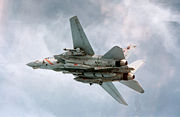
Cross-deck (naval terminology)
For the component of an aircraft carrier arresting gear , see Cross deck pendantCross-deck is United States Navy jargon which may refer to either informal, ad-hoc sharing of resources between naval vessels , or the use of carrier decks to host aircraft of foreign allies, aircraft from other ships...
between TARPS squadrons. Later, KS-153 LOROP cameras were also procured and also used as forward deployed assets. The KS-87 camera bay was eventually upgraded with a digital sensor so that imagery could be captured onto a PCMCIA Type II card for debrief, but could also be transmitted as desired by the RIO.
The TARPS mission first exposed the Tomcat to the AAA and SAM threat on a routine basis and spurred upgrades not only to the cameras, but to the aircraft itself. The existing RHAW gear, the ALR-45/50 was vintage Vietnam era and could not keep up with the latest threats of the SA-5 and SA-6, both present in several threat countries in the Mediterranean. As such, TARPS Tomcats were provided with an Expanded Chaff Adapter (ECA) rail that provided 120 extra expendable rounds and another rail that mounted an ALQ-167 "Bullwinkle" jammer. Eventually, the F-14B arrived with the improved ALR-67 RHAW gear capable of keeping pace with the latest threats. Prior to that, some Tomcat squadrons used modified "Fuzz-buster" automotive police radar detector
Radar detector
A radar detector is an electronic device used by motorists to detect if their speed is being monitored by police or law enforcement using a radar gun. Most radar detectors are used so the driver can reduce the car's speed before being ticketed for speeding...
s mounted ad hoc on the pilot's glare shield to detect threats not handled by the ALR-45/50.
Operational history
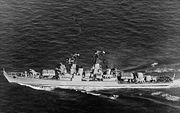
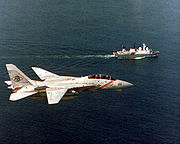
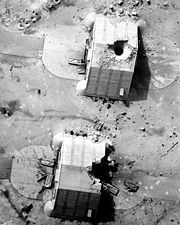
Lockheed U-2
The Lockheed U-2, nicknamed "Dragon Lady", is a single-engine, very high-altitude reconnaissance aircraft operated by the United States Air Force and previously flown by the Central Intelligence Agency . It provides day and night, very high-altitude , all-weather intelligence gathering...
/TR-1 and plentiful USAF RF-4 units. However, once Desert Storm started, the demand for realtime intel overwhelmed the other assets and TARPS missions were called upon to meet the demand. Immediately, it became obvious that Tomcats were favored for in country missions over the RF-4 as they required no escort and needed less fuel pre and post mission, which was a real concern at the time. TARPS continued to be utilized post Desert Storm and training was modified to take into account medium altitude tactics such as were flown in Desert Storm. Prior to that, the majority of TARPS missions training missions were low altitude overland and over water navigation and imagery. Only mapping was flown at medium altitudes. TARPS was used routinely in Operation Southern Watch over Iraq and called upon in Bosnia in 1995 and then again over Kosovo in 1999. The advent of LANTIRN
LANTIRN
Low Altitude Navigation and Targeting Infrared for Night, or LANTIRN, is a combined navigation and targeting pod system for use on the USAF's premier fighter aircraft — the F-15E Strike Eagle and F-16 Fighting Falcon...
into Tomcat operations provided a useful complement to TARPS. Since both systems need the same real estate in the rear cockpit for sensor operation control panels, they cannot be mounted on the aircraft at the same time, but they can be flown in formation yielding the best of both systems.
TARPS was used in the United States in 1993 when areas of the Mississippi River
Mississippi River
The Mississippi River is the largest river system in North America. Flowing entirely in the United States, this river rises in western Minnesota and meanders slowly southwards for to the Mississippi River Delta at the Gulf of Mexico. With its many tributaries, the Mississippi's watershed drains...
flooded. The Federal Emergency Management Agency
Federal Emergency Management Agency
The Federal Emergency Management Agency is an agency of the United States Department of Homeland Security, initially created by Presidential Reorganization Plan No. 1 of 1978 and implemented by two Executive Orders...
(FEMA) requested TARPS flights be taken over the area to determine which locations were hardest hit. TARPS has also been used for hurricane damage assessment.

